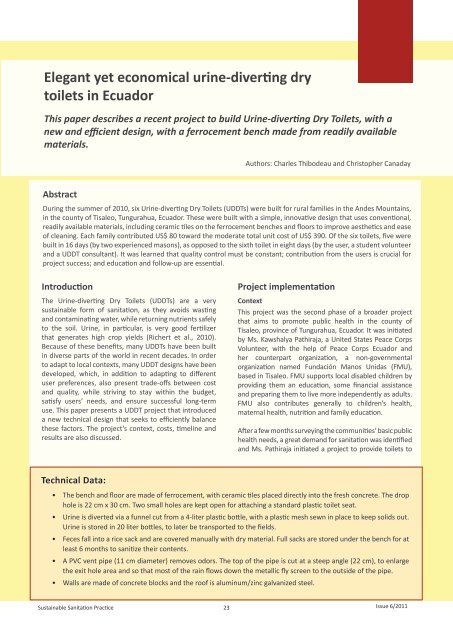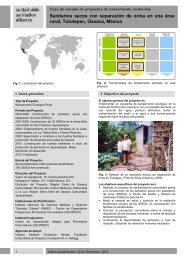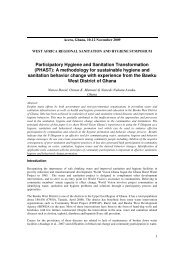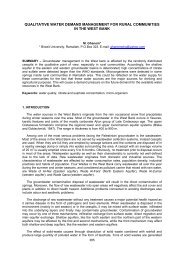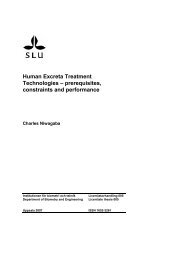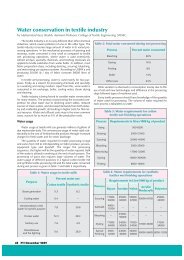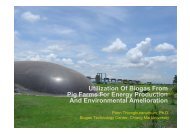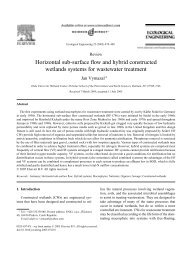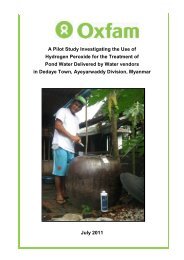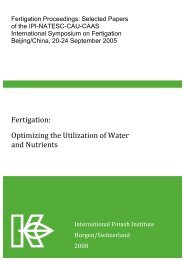Experiences with urine diverting dry toilets - EcoSan Club
Experiences with urine diverting dry toilets - EcoSan Club
Experiences with urine diverting dry toilets - EcoSan Club
You also want an ePaper? Increase the reach of your titles
YUMPU automatically turns print PDFs into web optimized ePapers that Google loves.
Elegant yet economical <strong>urine</strong>-<strong>diverting</strong> <strong>dry</strong><br />
<strong>toilets</strong> in Ecuador<br />
This paper describes a recent project to build Urine-<strong>diverting</strong> Dry Toilets, <strong>with</strong> a<br />
new and efficient design, <strong>with</strong> a ferrocement bench made from readily available<br />
materials.<br />
Abstract<br />
Technical Data:<br />
Sustainable Sanitation Practice<br />
23<br />
Authors: Charles Thibodeau and Christopher Canaday<br />
During the summer of 2010, six Urine-<strong>diverting</strong> Dry Toilets (UDDTs) were built for rural families in the Andes Mountains,<br />
in the county of Tisaleo, Tungurahua, Ecuador. These were built <strong>with</strong> a simple, innovative design that uses conventional,<br />
readily available materials, including ceramic tiles on the ferrocement benches and floors to improve aesthetics and ease<br />
of cleaning. Each family contributed US$ 80 toward the moderate total unit cost of US$ 390. Of the six <strong>toilets</strong>, five were<br />
built in 16 days (by two experienced masons), as opposed to the sixth toilet in eight days (by the user, a student volunteer<br />
and a UDDT consultant). It was learned that quality control must be constant; contribution from the users is crucial for<br />
project success; and education and follow-up are essential.<br />
Introduction<br />
The Urine-<strong>diverting</strong> Dry Toilets (UDDTs) are a very<br />
sustainable form of sanitation, as they avoids wasting<br />
and contaminating water, while returning nutrients safely<br />
to the soil. Urine, in particular, is very good fertilizer<br />
that generates high crop yields (Richert et al., 2010).<br />
Because of these benefits, many UDDTs have been built<br />
in diverse parts of the world in recent decades. In order<br />
to adapt to local contexts, many UDDT designs have been<br />
developed, which, in addition to adapting to different<br />
user preferences, also present trade-offs between cost<br />
and quality, while striving to stay <strong>with</strong>in the budget,<br />
satisfy users’ needs, and ensure successful long-term<br />
use. This paper presents a UDDT project that introduced<br />
a new technical design that seeks to efficiently balance<br />
these factors. The project’s context, costs, timeline and<br />
results are also discussed.<br />
Project implementation<br />
Context<br />
This project was the second phase of a broader project<br />
that aims to promote public health in the county of<br />
Tisaleo, province of Tungurahua, Ecuador. It was initiated<br />
by Ms. Kawshalya Pathiraja, a United States Peace Corps<br />
Volunteer, <strong>with</strong> the help of Peace Corps Ecuador and<br />
her counterpart organization, a non-governmental<br />
organization named Fundación Manos Unidas (FMU),<br />
based in Tisaleo. FMU supports local disabled children by<br />
providing them an education, some financial assistance<br />
and preparing them to live more independently as adults.<br />
FMU also contributes generally to children’s health,<br />
maternal health, nutrition and family education.<br />
After a few months surveying the communities’ basic public<br />
health needs, a great demand for sanitation was identified<br />
and Ms. Pathiraja initiated a project to provide <strong>toilets</strong> to<br />
• The bench and floor are made of ferrocement, <strong>with</strong> ceramic tiles placed directly into the fresh concrete. The drop<br />
hole is 22 cm x 30 cm. Two small holes are kept open for attaching a standard plastic toilet seat.<br />
• Urine is diverted via a funnel cut from a 4-liter plastic bottle, <strong>with</strong> a plastic mesh sewn in place to keep solids out.<br />
Urine is stored in 20 liter bottles, to later be transported to the fields.<br />
• Feces fall into a rice sack and are covered manually <strong>with</strong> <strong>dry</strong> material. Full sacks are stored under the bench for at<br />
least 6 months to sanitize their contents.<br />
• A PVC vent pipe (11 cm diameter) removes odors. The top of the pipe is cut at a steep angle (22 cm), to enlarge<br />
the exit hole area and so that most of the rain flows down the metallic fly screen to the outside of the pipe.<br />
• Walls are made of concrete blocks and the roof is aluminum/zinc galvanized steel.<br />
<br />
<br />
<br />
<br />
Issue 6/2011


